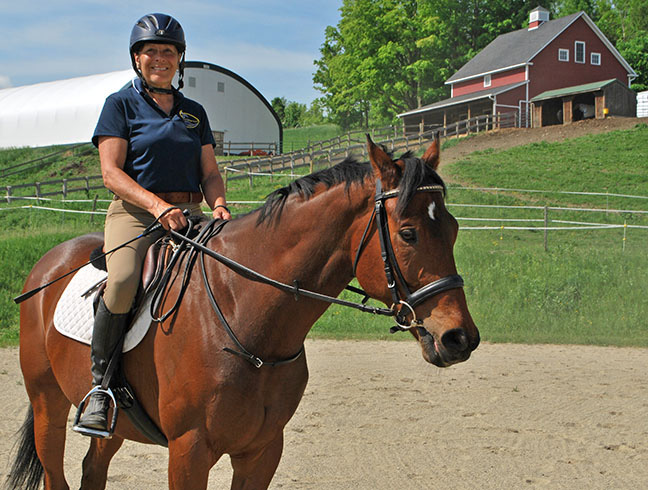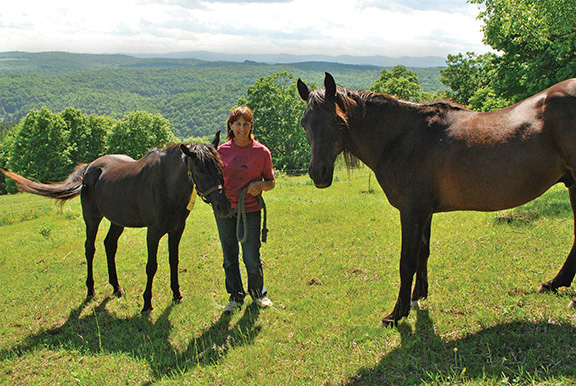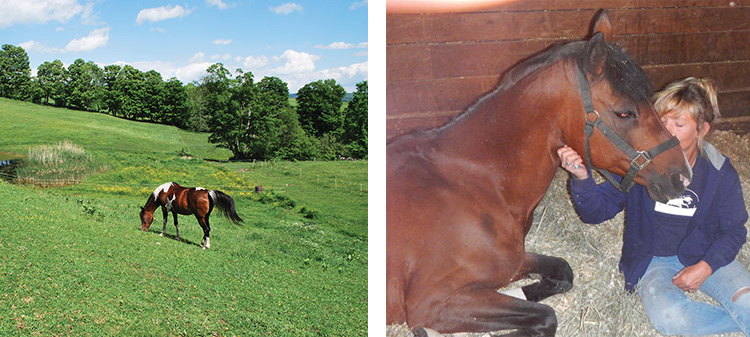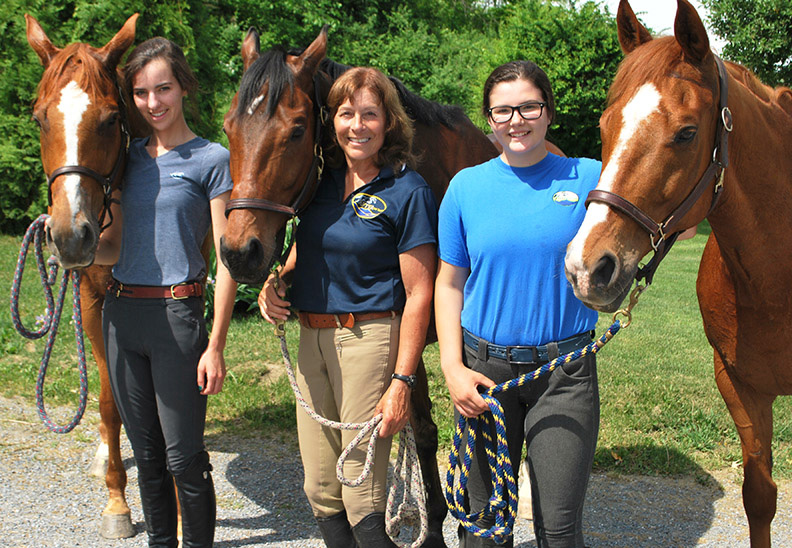| To the Rescue: Women in Vermont Providing for Animals in Need | ||||||||
by Michelle A. L. Singer |
||||||||
|
||||||||
On May 7, 2016, the Kentucky Derby—one of the most prestigious horse races in the world and the longest continually held sporting event in America—offered a $2 million dollar purse to the winner of the race. This year it was Nyquist, a three-year-old colt. For some, that headline prompts a compelling question: What about the thousands of other thoroughbred racehorses that didn't make it to the Kentucky Derby? What happens to them? Ginny Iverson, executive director and head trainer of AFTER the Track at Lakota~Way Farm in Hinesburg, Vermont, knows the answer. She says approximately 25,000 horses are bred to race in the Kentucky Derby, but only 20 make it. Of the rest of the 24,980 horses, "some... will continue racing in the lower races, but many of them will soon be out of work. The median age for thoroughbreds retiring from racing is 5 to 6 years old, yet the average lifespan of these horses is 25 to 30 years. These are young, healthy, athletic horses who can be retrained in other disciplines and bring years of pleasure to riding enthusiasts." This is where Iverson and others like her step in. AFTER the Track (AFTER is the acronym for Assuring Futures for Thoroughbred Ex Racehorses) seeks unsuccessful racehorses that have the potential to become good sport and pleasure horses for adult amateur, junior, and professional riders. Because the horses are purchased outright from the racetrack, they are not rescue animals, but they are still very much at-risk. A not uncommon fate for these horses is the slaughterhouse. Horse slaughter is illegal in the United States, so each year thousands of unsuccessful thoroughbreds are shipped to Canada, Mexico, or even Japan to be butchered. Fortunately, more and more thoroughbred aftercare programs are being founded throughout the country. AFTER the Track is Vermont's only thoroughbred aftercare program and stands ready to help others expand and replicate this worthy effort.
Typically, Iverson spends at least a year with a horse after it has come off the track to get it used to a different life. Everything from its diet, tack, and daily routine to expectations around manners, behavior, and work changes. Even the horse's shoes need to be changed. While at the track, thoroughbreds don't spend time in pastures, and oftentimes when they arrive at Lakota~Way Farm, it takes Iverson days to encourage them to step out of the stable and into open air. AFTER the Track can care for 14 horses, with some boarders and personal horses also at the farm at any given time. With 28 acres, indoor and outdoor arenas, lots of pasture, and an extensive trail system, the horses at the farm have plenty of space with room for more. Iverson would like to hire staff and help more thoroughbred horses. The difficulty is money; caring for horses is expensive. All told, between veterinarian and farrier (shoeing) bills and the cost of blankets and tack, room and board, and training, each horse racks up a tab of nearly $15,000 per year.
Iverson uses a network of professionals she trusts both to find horses she can help and to find homes for horses ready for adoption. If you visit her stable in the hills of Hinesburg, you might meet Aquila, a racehorse that went by the name Sugar Princess. She came to AFTER the Track quite tired after a very busy racing season. Now she hangs out in the pasture with her best friend, Diva, when she isn't training. Like others at the farm, she's becoming an accomplished sport horse that Iverson will look to match with the right rider and owner. In addition to helping retired racehorses, AFTER the Track offers educational internships for high school and college students in equine care, including horsemanship, farm management, and business innovations. It currently has formal partnerships with Champlain Valley Union High School and the University of Vermont. Over the past three years, more than 15 high school and college students have received academic credit and invaluable experience through their internships at AFTER the Track.
Iverson's aftercare work with thoroughbreds is unique in Vermont, but she is one of many women who have formed nonprofits to care for horses in need. Two of them, Deborah Baker and Gina Brown, focus their care on horses and other animals that have suffered neglect and abuse. Sixty-five miles away from Lakota~Way Farm, in the hills of Chelsea, Vermont, sits the Hooved Animal Sanctuary, a nonprofit rescue farm run by Baker since 2003. Her 125 acres have a beautiful, nearly 360-degree view of the mountains and plenty of pasture for the animals she cares for to live and heal on, much like AFTER the Track.
"See that horse out there?" she says, pointing out to a field. "He's blind in one eye. He came from southern Vermont. He was abandoned by his owner who was arrested in a drug bust." The owner didn't make plans for his horse, just left him alone at his house when he went to jail. "I don't know if that's when the eye injury happened," Baker says. "Someone said he'd been tied to a tree in the woods and left, but I don't know if that's true. He's a good horse and used to be ridden, but he came into the wrong hands." When Baker posted a photo of this new addition to the farm on Facebook, the horse's original owner recognized him and reached out to the farm. The former owner was devastated to see him in such bad condition but felt much better after visiting the farm and seeing him make a recovery. "It doesn't take long for things to go wrong," says Baker. The Hooved Animal Sanctuary, as its name implies, also serves as a rescue for other animals with hooves. Baker gets sheep, cows, pigs, and a lot of goats. People like to get adorable baby goats as pets, until they discover, she says, that "they can't keep them in." Once goats learn to jump fences, they are quite difficult to keep. However, Baker has an ideal neighbor with very good fencing. In exchange for help keeping her cows, the elderly woman is happy to foster goats on her well-fenced property where she also used to keep sheep. Baker is able to rehome goats to people who have herds of them for grazing and milking. Pigs are not as easy to rehome. Again, people may buy an adorable piglet, not thinking ahead to the 700-pound adult it will become. Pigs, according to Baker, can live well into their teens, and when people surrender their large pigs with the stipulation that they cannot be eaten, it's not easy to find a home for them. For this reason, a part her of nonprofit's mission is education and community outreach. She offers open houses and clinics and does outreach at horse shows to help educate people about the work it takes to care for animals.
Baker has the capacity for around 10 horses at her farm. This past December, just before Christmas, she took in five horses—part of a group of 14 that had been seized on a cold, windy, well-below-zero Vermont night. The horses were in the open with no shelter, just a small fenced-in area, and in poor condition, says Baker. "One didn't make it," she adds. She will have them until June when she hopes she will be granted custody of them. Then comes the hardest part: finding good adoptive homes for them. She looks for the right people and the best situations, which can be tricky for horses that cannot be ridden due to injury or temperament. "Rehoming of rescue animals is tough," she says. "I wish there was an easier way." Baker has been riding horses since she was 9 and showing them since she was 16, and she's just never stopped. She introduced me to Whisper, her own horse, who tried to eat both my shoelaces and clipboard, a very friendly horse. Baker works full-time caring for the horses at her sanctuary. The very basics of housing and feeding cost hundreds of dollars every month for each horse and take up much of her time. It is typically three months, she explains, before she sees improvement in a newly arrived horse. The horses are first tested and then treated, getting dental work and farrier work. She assesses whether or not a horse can be ridden and spends time training it so that it will have the appropriate manners and be safe with its new owner. She relies on donations, big and small, to do the work she does. The new section of her barn, with three large stalls, was made possible by a large donation. Another few stalls in a shed on the hill were made possible by a grant. She welcomes donations of materials, time, skills, food, and, of course, money. There is no single state-funded location for large animal rescue in Vermont. Every rescue is a community effort and relies on a network of volunteers and animal sanctuaries like Baker's. Baker herself is a large animal investigator for Orange County, also a volunteer position. She works in the field to educate people and offers resources and referrals. When the state seized 21 horses from Bona Ranch in Lyndonville last March, where the horses were so hungry they were eating the wooden fencing, there was no place to keep them together, attend to their veterinary needs, and care for them through the court process. The state relied on volunteers and a network of caregivers, like Baker, to take as many horses as they could. There were over 30 people helping, including a veterinarian, on the day the horses were seized, and it was the Hooved Animal Sanctuary that took the two in the worst condition. Spring Hill Horse Rescue of Clarendon, Vermont, was also involved, assisting with documentation and handling the animals. Spring Hill was not able to take any of the animals because the farm is at capacity and has been for some time, but the work Spring Hill employees do filling out paperwork and documenting the cases is essential.
Since Spring Hill was started in 2000, it has rescued, rehabilitated, and rehomed over 750 horses and close to 1,000 animals. Executive Director Gina Brown is also a humane agent, working with animal welfare organizations and law enforcement and conducting animal cruelty investigations throughout Vermont. She is a board member of Vermont Humane Federation and involved with the Vermont Animal Cruelty Response Coalition. Her organization, however, has just lost its commercial liability insurance, putting her and her board personally liable and at risk. No claim has ever been filed against the organization; it has never been sued and never had a safety incident. In fact, three days after Spring Hill received the letter stating the insurance was cancelled, it received a safety award from the North American Horseman's Association, which is associated with Spring Hill's former insurer. The organization has been unable to find a new insurer. "It's frustrating," says Brown. "It's one more obstacle in our way of doing the right thing for the animals. It's another reason why the state needs to be more involved, especially when it comes to large animals like horses and other livestock. There are not enough facilities to take them in."
Since they have as many animals as they can care for already, Brown and her volunteers focus on investigating cruelty complaints, helping people keep their animals, and doing the laborious documentation work that is critical to the success of cases that do need legal action. "The past few years animal cruelty has been in the limelight, and it's because of the work we do. Some cases have pushed us to the brink of going under because of the cost of rehabilitation and expensive surgeries. Who pays for that? The public is paying through 501(c)3 donations and some grants. Our entire budget goes to the care of the animals. We only have two part-time employees, myself and Brenna Wright, who does administrative work and the banking. Our board president, Deborah Loring, volunteers a lot of time to fundraise and is also a humane agent." The Vermont Humane Federation did create a cruelty response system with a website platform that allows people to file cruelty complaints (see below). However, according to Brown there are a large number of complaints and no consistent way to follow through with them. Each town or village will have a different agency, or person, in charge of handling the complaint and will process it differently. In one town, it might be an animal control officer, in another the constable. Some towns may not have law enforcement and rely on town selectmen. There's no consistency throughout the state for who's responsible, or if they have the training to identify abuse and neglect. "A lot of time is wasted," says Brown. "A lot of complaints need to be investigated, but there are not enough trained people to do them, so they rely on volunteers. That can put us in a dangerous position. I've been spit on. I've been accosted." Yet, she continues. She knows there's more work to be done.
Ginny Iverson, Deborah Baker, and Gina Brown have all loved horses and worked with them from a very young age. They put in the bulk of the physical labor, gentle training, and administrative legwork to keep their nonprofit organizations running. They each bring a deep connection and caring to their calling as advocates and caretakers of the animals they serve. Without them, thousands of animals in need in Vermont would have met a very different fate. Without adequate state organization or funding, they are among the many volunteers who create a safety net for animals in need. They are, as Baker says on her website, "part of what's right with the world."
Horse owners who need help feeding their animals can get temporary help through the Vermont Hay Bank, www.vermonthumane.org under the Equine Assistance Program. People are encouraged to report cases of abuse to the Animal Cruelty Case Management and Reporting System of Vermont where you can fill out an Animal Cruelty Reporting Form at www.reportanimalcruelty.com. Learn more about AFTER the Track at www.afterthetrack.org. Find the Hooved Animal Sanctuary on Facebook or www.hooved.org to keep up with clinics, events, and horses that are available for adoption; it partners with another sanctuary in Maine, where two of its horses will be for this summer. Contact Spring Hill Horse Rescue at www.springhillrescue.com. You can donate to all these organizations on their websites. |
||||||||
|
Michelle A. L. Singer is a freelance writer and coordinator of PoemCity in Montpelier. She also enjoys volunteering at her local thrift shop and teaching poetry in her kids’ classrooms.
|
|||||||







